Most Important Items
They may not get much attention, but gutters are one of the most important items outside your house. Gutters are attached at the leading edges of the roof on all sides. When heavy rains fall, they collect the water that runs off the roof and direct the water away from the foundation through downspouts that either empty onto the ground near your house, into a rain barrel, or underground several feet away from the house and up through a pop-up drain.
The rest of the time, your gutters are like the junk drawer in your kitchen. They collect everything- leaves, acorns, sticks, pollen, and more. These items keep your gutters from working properly and potentially lead to damage to your entire home, from foundation to roof.
Here are just a few of the ways clogged and overflowing gutters can damage your home:
- Overflowing gutters allow water to pool back onto your roof, causing excessive shingle damage and a higher risk of roof sags, cracks, and leaks.
- Gutters full of debris are likely to sag or break under the weight of the rotting debris, causing repair or replacement of the entire line.
- Large chunks of debris can flow into the downspouts and get stuck in the elbows and seams. This will cause even more water to back up in the gutters.
- Because the water will pool near the home, the likelihood of flooding increases, especially in basements, walkways, driveways, garden beds, lawns, or anywhere else the ground is lower than the surrounding area.
- Water pooled at the base of the house is absorbed by the concrete causing it to swell and crack, making the home unstable.
- When water starts leaking into the walls, and ceiling, or flooding the basement, mold can develop, potentially causing a variety of respiratory issues.
Easiest Way To Prevent Damage
The easiest way to prevent damage to your home from clogged gutters is to have gutter protection systems installed. These systems go by many names, including leaf guards, gutter covers, gutter helmets, or gutter guards. They all do the same thing, which is to keep the debris out of your gutters, reduce maintenance costs, and allow the water to flow through but the junk floats off the top.
The most popular styles of gutter guards are:
- Bottle Brush- The least expensive and easiest to install, the brushes sit in the gutter and do not attach to the roof. Can blow away or be carried off by animals, clog easily, and require maintenance.
- Foam- Also inexpensive and easy to install, these long, dense triangular pieces of foam slide into the gutter system. Water flows through the foam, but some water, plant life, and some debris can still get trapped in the foam.
- Vinyl and Plastic- Similar design to professionally installed gutter covers but can be installed by the homeowner, these guards are less prone to clogging than brush and foam inserts. Easily warped, broken, or bent during cleaning or by weather or heavy debris on top and can fall off.
- Perforated- Often made of aluminum, these guards are rust-resistant and attach to the gutters themselves. Must be professionally installed and removed. Small debris like pine needles can still get in, but heavy rain or good wind can flush the debris out through the downspouts.
- Reverse Curve- These guards have a slotted opening at the end so water goes in and debris goes over the side. These are not appropriate for steep roofs, as there may be too much momentum for the water to slide into the gutters.
- Micro-mesh- The most expensive of the gutter covers, these are made of a fine mesh with a metal structural backing that must be professionally installed. They do, however, filter out almost all debris and last much longer than the other protection systems.
Regular Maintenance Is Still Required
No matter what type of gutter protection you have installed, regular maintenance is still required. If purchasing and installing a system yourself, hire a professional to inspect and clean out your gutters.





